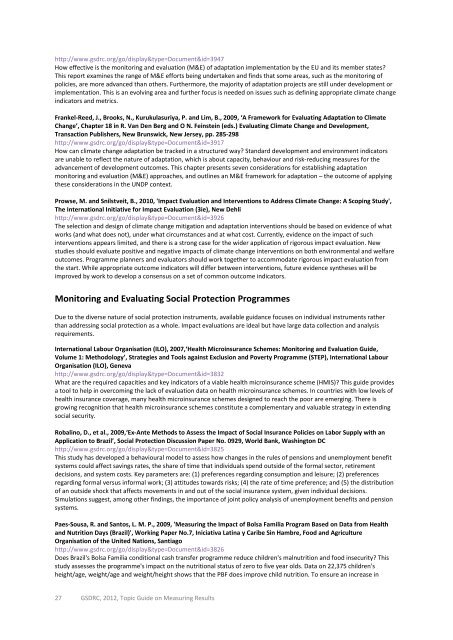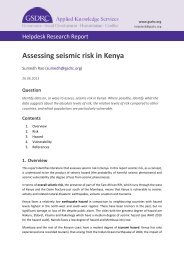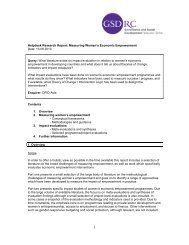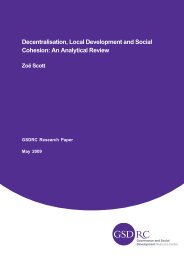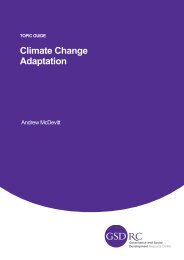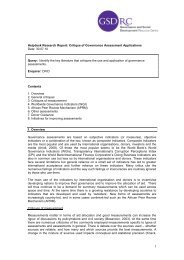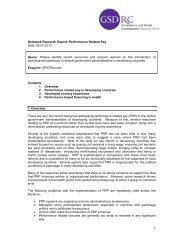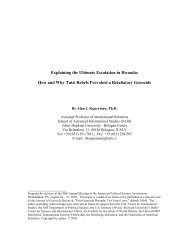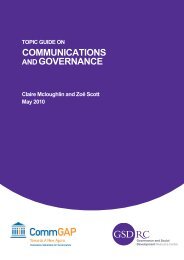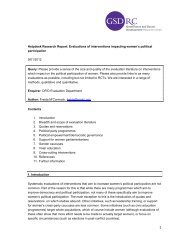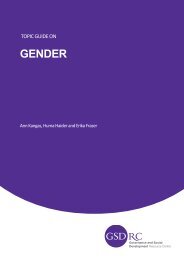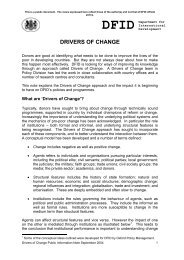PDF (28 pages; 360 KB) - GSDRC
PDF (28 pages; 360 KB) - GSDRC
PDF (28 pages; 360 KB) - GSDRC
Create successful ePaper yourself
Turn your PDF publications into a flip-book with our unique Google optimized e-Paper software.
http://www.gsdrc.org/go/display&type=Document&id=3947How effective is the monitoring and evaluation (M&E) of adaptation implementation by the EU and its member states?This report examines the range of M&E efforts being undertaken and finds that some areas, such as the monitoring ofpolicies, are more advanced than others. Furthermore, the majority of adaptation projects are still under development orimplementation. This is an evolving area and further focus is needed on issues such as defining appropriate climate changeindicators and metrics.Frankel-Reed, J., Brooks, N., Kurukulasuriya, P. and Lim, B., 2009, ‘A Framework for Evaluating Adaptation to ClimateChange’, Chapter 18 in R. Van Den Berg and O N. Feinstein (eds.) Evaluating Climate Change and Development,Transaction Publishers, New Brunswick, New Jersey, pp. <strong>28</strong>5-298http://www.gsdrc.org/go/display&type=Document&id=3917How can climate change adaptation be tracked in a structured way? Standard development and environment indicatorsare unable to reflect the nature of adaptation, which is about capacity, behaviour and risk-reducing measures for theadvancement of development outcomes. This chapter presents seven considerations for establishing adaptationmonitoring and evaluation (M&E) approaches, and outlines an M&E framework for adaptation – the outcome of applyingthese considerations in the UNDP context.Prowse, M. and Snilstveit, B., 2010, 'Impact Evaluation and Interventions to Address Climate Change: A Scoping Study',The International Initiative for Impact Evaluation (3ie), New Dehlihttp://www.gsdrc.org/go/display&type=Document&id=3926The selection and design of climate change mitigation and adaptation interventions should be based on evidence of whatworks (and what does not), under what circumstances and at what cost. Currently, evidence on the impact of suchinterventions appears limited, and there is a strong case for the wider application of rigorous impact evaluation. Newstudies should evaluate positive and negative impacts of climate change interventions on both environmental and welfareoutcomes. Programme planners and evaluators should work together to accommodate rigorous impact evaluation fromthe start. While appropriate outcome indicators will differ between interventions, future evidence syntheses will beimproved by work to develop a consensus on a set of common outcome indicators.Monitoring and Evaluating Social Protection ProgrammesDue to the diverse nature of social protection instruments, available guidance focuses on individual instruments ratherthan addressing social protection as a whole. Impact evaluations are ideal but have large data collection and analysisrequirements.International Labour Organisation (ILO), 2007,‘Health Microinsurance Schemes: Monitoring and Evaluation Guide,Volume 1: Methodology’, Strategies and Tools against Exclusion and Poverty Programme (STEP), International LabourOrganisation (ILO), Genevahttp://www.gsdrc.org/go/display&type=Document&id=3832What are the required capacities and key indicators of a viable health microinsurance scheme (HMIS)? This guide providesa tool to help in overcoming the lack of evaluation data on health microinsurance schemes. In countries with low levels ofhealth insurance coverage, many health microinsurance schemes designed to reach the poor are emerging. There isgrowing recognition that health microinsurance schemes constitute a complementary and valuable strategy in extendingsocial security.Robalino, D., et al., 2009,‘Ex-Ante Methods to Assess the Impact of Social Insurance Policies on Labor Supply with anApplication to Brazil’, Social Protection Discussion Paper No. 0929, World Bank, Washington DChttp://www.gsdrc.org/go/display&type=Document&id=3825This study has developed a behavioural model to assess how changes in the rules of pensions and unemployment benefitsystems could affect savings rates, the share of time that individuals spend outside of the formal sector, retirementdecisions, and system costs. Key parameters are: (1) preferences regarding consumption and leisure; (2) preferencesregarding formal versus informal work; (3) attitudes towards risks; (4) the rate of time preference; and (5) the distributionof an outside shock that affects movements in and out of the social insurance system, given individual decisions.Simulations suggest, among other findings, the importance of joint policy analysis of unemployment benefits and pensionsystems.Paes-Sousa, R. and Santos, L. M. P., 2009, 'Measuring the Impact of Bolsa Familia Program Based on Data from Healthand Nutrition Days (Brazil)', Working Paper No.7, Iniciativa Latina y Caribe Sin Hambre, Food and AgricultureOrganisation of the United Nations, Santiagohttp://www.gsdrc.org/go/display&type=Document&id=3826Does Brazil's Bolsa Familia conditional cash transfer programme reduce children's malnutrition and food insecurity? Thisstudy assesses the programme's impact on the nutritional status of zero to five year olds. Data on 22,375 children'sheight/age, weight/age and weight/height shows that the PBF does improve child nutrition. To ensure an increase in27 <strong>GSDRC</strong>, 2012, Topic Guide on Measuring Results


